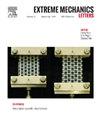Multiple broad bandgaps soundproofing for sectoral labyrinthine metamaterials
IF 4.5
3区 工程技术
Q2 MATERIALS SCIENCE, MULTIDISCIPLINARY
引用次数: 0
Abstract
Acoustic metamaterials are notable for their light weight and exceptional ability to control low-frequency sounds, making them ideal for applications requiring both soundproofing and ventilation. In this paper, metamaterials with various labyrinthine structures were designed using the space-coiling strategy, featuring sectoral labyrinthine resonators arranged in a circular pattern around a central circular passage for airflow. The noted metamaterials were categorized into four levels based on the use of different sectoral resonators. In level-1, all resonators were identical, while in levels 2, 3, and 4, two, three, and four different resonators were used, respectively. The sound insulation performance was evaluated through Sound Transmission Loss (STL) test using an impedance tube, as well as numerical simulations. The results indicated that the development of level-1 geometric configurations led to a shift in the STL curves toward higher frequencies and an increase in the width of the first bandgap. The widest observed bandgap was in the frequency range of 937–2078 Hz, covering approximately 55 % of the targeted frequency range (below 2000 Hz). With the introduction of higher-level configurations, multiple bandgaps, along with several peaks, appeared in the STL spectra. These multiple bandgaps result from Fano resonances generated by the various sectoral resonators. Fano resonances are inversely related to the effective length of each sectoral resonator, allowing for tuning to achieve different sound insulation performances. The maximum frequency coverage was approximately 50 % for level-2, around 40 % for level-3, and about 30 % for level-4.
扇形迷宫式超材料的多重宽带隙隔音
声学超材料以其重量轻和控制低频声音的特殊能力而闻名,使其成为需要隔音和通风的应用的理想选择。本文采用空间卷绕策略设计了具有各种迷宫结构的超材料,其特点是扇形迷宫谐振器围绕中心圆形通道以圆形图案排列。根据使用不同的扇形谐振器,将上述超材料分为四个级别。在第1级中,所有谐振器都是相同的,而在第2、3和4级中,分别使用了2、3和4个不同的谐振器。通过阻抗管的声传输损失测试和数值模拟来评估隔声性能。结果表明,一级几何构型的发展导致STL曲线向更高频率偏移,第一带隙宽度增加。观测到的最宽带隙在937-2078 Hz的频率范围内,覆盖了目标频率范围(低于2000 Hz)的约55 %。随着更高能级结构的引入,STL光谱中出现了多个带隙和多个峰。这些多重带隙是由各种扇形谐振器产生的范诺谐振引起的。范诺共振与每个扇形谐振器的有效长度成反比,允许调整以实现不同的隔音性能。第2级的最大频率覆盖率约为50 %,第3级约为40 %,第4级约为30 %。
本文章由计算机程序翻译,如有差异,请以英文原文为准。
求助全文
约1分钟内获得全文
求助全文
来源期刊

Extreme Mechanics Letters
Engineering-Mechanics of Materials
CiteScore
9.20
自引率
4.30%
发文量
179
审稿时长
45 days
期刊介绍:
Extreme Mechanics Letters (EML) enables rapid communication of research that highlights the role of mechanics in multi-disciplinary areas across materials science, physics, chemistry, biology, medicine and engineering. Emphasis is on the impact, depth and originality of new concepts, methods and observations at the forefront of applied sciences.
 求助内容:
求助内容: 应助结果提醒方式:
应助结果提醒方式:


